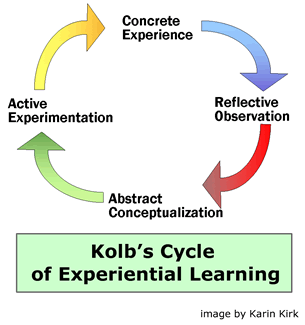How do we apply Experience in learning?

1) Kolb's Theory
Experience Learning - 4 steps of learning cycle from Kolb’s Theory
Kolb's experiential learning cycle concept divides the learning process into a cycle of four basic theoretical components: concrete experience, reflective observation, abstract conceptualization, and active experimentation.
Kolb's Experiential Learning Theory presents a cycle of four elements
-
Concrete Experience
Thinking: “The learner actively experiments with a concept” (Fewster-Thuente & Batteson, 2018) -
Reflective Observation
Watching: “The learner consciously reflects back on that experience” (Fewster-Thuente & Batteson, 2018) -
Abstract Conceptualization
Thinking: “The learner attempts to generalize a model of what is experienced” (Fewster-Thuente & Batteson, 2018) -
Active Experimentation
Doing: “The learner applies the model to a new experiment” (Fewster-Thuente & Batteson, 2018)
2) Prototyping
Prototyping is an essential part of design thinking and learning experience design because it’s the easiest way to test our ideas and improve on them.